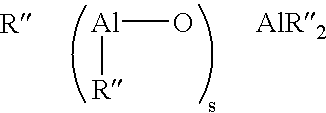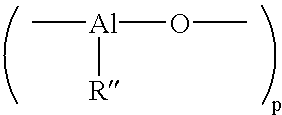Self-supported hybrd catalysts for the production of polyolefins
- Summary
- Abstract
- Description
- Claims
- Application Information
AI Technical Summary
Benefits of technology
Problems solved by technology
Method used
Image
Examples
example 1
[0091] Preparation of the Self Supported Cycloalkadienyl Hf / Zr Catalyst
[0092] A mixed magnesium-hafnium-zirconium alkoxide complex was prepared as follows.
3Mg(OEt).sub.2+0.55HfCl.sub.4+0.40Zr(OBu).sub.4+0.15Zr(OEt).sub.4+0.1HOC.s- ub.6H.sub.4CO.sub.2Me+3.8EtOH.fwdarw.
[0093] HfCl.sub.4 (4.40 g, 13.75 mmol), Zr(OEt).sub.4 (1.02g, 3.75 mmol) and Zr(OBu).sub.4 (4.40 g, 87.5%, 10.0 mmol) were mixed with ethanol (5.6 ml, 4.4 g, 95 mmol) in an 8 ounce bottle, and then methyl salicylate (0.38 g, 2.5 mmol) was added and the mixture allowed to stir overnight at room temperature to obtain a straw yellow solution. To the bottle was added 70 g of chlorobenzene followed by Mg(OEt).sub.2 (8.58 g, 75 mmol) followed by another 30 g of chlorobenzene. The bottle was placed in a 100.degree. C. oil bath and stirred for 120 minutes at 440 rpm whereupon all of the magnesium ethoxide granules appeared to have dissolved. The bottle cap was removed and a gentle flow of nitrogen passed over the reaction until...
example 2
[0097] A magnesium zirconium alkoxide complex was prepared as follows:
Preparation of Mg and Zr-Containing Precursor
[0098] A magnesium and zirconium-containing precursor was prepared via the following reaction:
3Mg(OEt).sub.2+0.55ZrCl.sub.4+0.40Zr(OBu).sub.4+0.15Zr(OEt).sub.4+0.05HOC.- sub.6H.sub.4CO.sub.2OMe+4.8EtOH.fwdarw.
[0099] A. About 32.0 grams of ZrCl.sub.4 (138 mmol), Zr(OEt).sub.4 (10.2 g, 37.5 mmol) and Zr(OBu).sub.4 (44.0 g, 87.5%, 100 mmol) were mixed with 71 ml of Ethanol (55.5 g, 1.2 mol) in a quart bottle. Methyl salicylate (1.9 g, 12.5 mmol) then was added and the mixture stirred overnight at room temperature (solution gets warm) to obtain a yellow to dark-brown solution (solids were totally dissolved). The solution was diluted with 660 g of chlorobenzene. The bottle was given a quick purge of nitrogen, capped tightly and placed in a silicone fluid (PDMS, 20cs) bath which was heating to 75.degree. and stirred at 440rpm. When the material temperature reached 65.degree. ...
example 3
[0108] Preparation of the Self-Supported Hybrid Catalyst
[0109] About 2.298 gm of the self supported cycloalkadienyl Zr catalyst prepared in Example 2, was slurried in 10 ml of hexane. Over the course of about 2 minutes, 11 ml of a solution composed of 20% SiCl.sub.4+5% TiCl.sub.4+75% toluene was added. The resulting dark brown slurry was stirred at room temperature for about an two hours then the solids collected by filtration. The solids were washed three times with hexane and dried under moving nitrogen to yield 2.658 g of brown powder. About 1.355 g or the brown powder was slurried in 5 ml of hexane then 5 ml of SiCl.sub.4 / TiCl.sub.4 / toluene was added and the mixture stirred for 30 minutes and the solids collected by filtration. The solids were washed once with toluene then three times with hexane and dried under moving nitrogen. The yield of brown powder was 1.34 g. A sample was prepared for polymerization testing by mixing 100 mg of the powder into 20 ml of Kaydol oil.
[0110] Po...
PUM
| Property | Measurement | Unit |
|---|---|---|
| Time | aaaaa | aaaaa |
| Partial pressure | aaaaa | aaaaa |
| Percent by mole | aaaaa | aaaaa |
Abstract
Description
Claims
Application Information
 Login to View More
Login to View More - R&D
- Intellectual Property
- Life Sciences
- Materials
- Tech Scout
- Unparalleled Data Quality
- Higher Quality Content
- 60% Fewer Hallucinations
Browse by: Latest US Patents, China's latest patents, Technical Efficacy Thesaurus, Application Domain, Technology Topic, Popular Technical Reports.
© 2025 PatSnap. All rights reserved.Legal|Privacy policy|Modern Slavery Act Transparency Statement|Sitemap|About US| Contact US: help@patsnap.com



